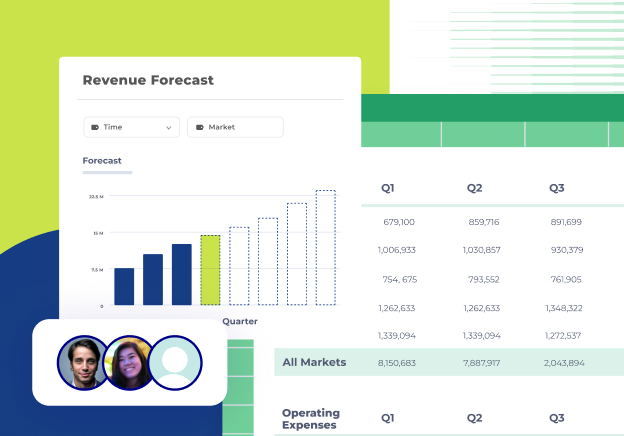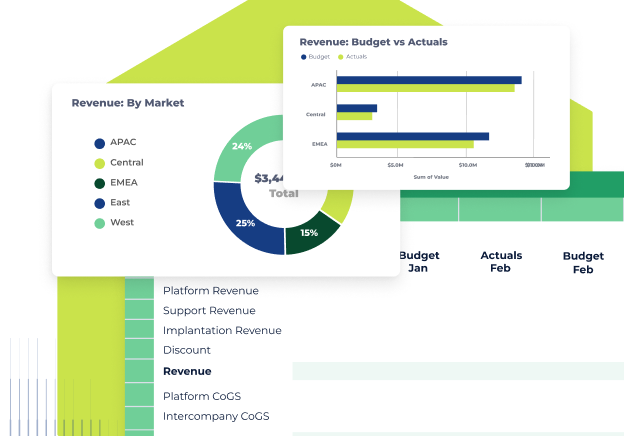Key takeaways:
- Corporate performance management (CPM brings together strategic planning, data-driven insights, and collaboration to help businesses work smarter and grow sustainably.
- For finance teams, CPM often overlaps with FP&A processes, ensuring decisions are tied to measurable outcomes.
- The right CPM tools and strategies can streamline workflows, track performance, and drive meaningful change
What is corporate performance management (CPM)?
Corporate performance is an overall assessment of how successfully a corporation is performing. Typically, this means monitoring its most important financial, market, and shareholder performance parameters.
In reality, “keeping an eye” on corporate performance isn’t enough to ensure business success.
Enter corporate performance management (CPM). CPM is the collection of intentional strategies, metrics, processes, and systems used to strive for a thriving organization.
What is CPM in financial management?
Corporate performance management can feel very broad if not considered through a financial lens.
While every element of running the business could be considered CPM, when it comes to financial management, CPM is most related to all the motions and methodologies needed to align the company's financial activities with its overall goals.
How does corporate performance management work?
Frequently, CPM operates as a subset of business intelligence that monitors corporate health according to key performance indicators (KPIs) such as revenue, return on investment (ROI), overhead, and operational costs.
Like all mission-critical business strategies, CPM is a collaborative effort: you need metrics from every department to understand the organization's accurate financial health. In order to collect data across departments, corporate performance management teams up with financial planning and analysis (FP&A).
FP&A is the set of strategic activities (planning, budgeting, forecasting, and financial analysis) that enable a company's ongoing financial health and ability to grow.
It’s been said you can’t manage what you can’t measure, so partnering with FP&A to collect and analyze financial data is critical for CPM teams. FP&A enhances the finance department’s ability to manage performance by integrating corporate strategy and decision-making—all part of CPM.
Components of corporate performance management
Various factors are considered when monitoring an organization's financial health against its goals.
Of course, to set those goals, strategic planning is the essential first step in corporate performance management. From there, organizations typically create budgets and forecasts to create projections for the strategic plan.
Finance teams continuously aggregate data, run analyses, and build reports to monitor performance against the plans and projections.

Why corporate performance management is important for businesses
When following CPM best practices, the core decision-makers in a company will gain the information required to make decisions needed to improve financial health. In order to complete this successfully, corporate performance managers use CPM software that allows for automation, collaboration, and quick decision-making.
Better risk management
Managing risk effectively is key to steering a company toward success. CPM offers a structured approach to identify and address potential risks before they become significant issues. By continuously monitoring data, organizations can act swiftly, keeping their financial health in check and ensuring sustainable growth.
Real-time feedback
Instead of reviewing data weekly, monthly, or yearly, CPM software empowers organizations to view data—and the analysis of this data—in real time. This means more timely decisions and less opportunity for errors to become serious financial issues. This rapid feedback loop not only prevents small discrepancies from snowballing into major financial problems but also allows companies to capitalize on opportunities before competitors who rely on traditional reporting cycles can react.
Improved data management
Data collection, consolidation, reporting, closing, and analysis can all be prone to human error and time-consuming. Corporate performance managers utilize automation and integration of source systems to minimize opportunities for human error.
By connecting directly to ERP, CRM, and other operational systems, they eliminate redundant data entry and create audit trails that ensure accuracy. This integration not only reduces errors but also cuts processing time from days to hours, allowing finance teams to focus on analysis rather than data wrangling.
Easier project management and collaboration
CPM software makes managing strategic projects easier with smart automation, advanced data consolidation, and seamless collaboration. With real-time feedback and company-wide cloud access, communications are streamlined and all teams can work off a single source of truth.
With the stakes of unorganized data, inaccurate analysts, and unreliable reporting being so high—namely, being blindsided with serious financial struggles, strong CPM is key.
Simpler planning
CPM requires input from all departments to create a sophisticated planning process. However, gaining access to data across departments isn’t as easy as it may sound. Sources of data on the financial health of the company might include the following teams and systems:
- Operations: Operational data is typically housed in an Enterprise Resource Planning (ERP) system, such as Oracle, SAP, and others.
- Sales: Sales, customer, and account data is managed through a CRM system, such as Salesforce, Netsuite, Microsoft Dynamics, and others.
- Human resources (HR): HR teams use human resources information management systems, such as Atlassian, Zenefits, and others.
- Accounting and finance: Accounting and finance teams manage financial activities with tools such as Sage Intacct, Xero, QuickBooks, and others.
- Payroll: HR and/or accounting manage workforce payroll through systems such as ADP Payroll, Paychex, Quickbooks, and others.
- IT: For broader or more detailed analysis, modeling, and scenario planning, FP&A may need to work with IT to gather data from business intelligence (BI), data warehouse, analytics, or other back-office systems.
Add all these pieces together and it’s clear sophisticated CPM reigns supreme over manual methods.
CPM metrics to track
CPM software solutions track key performance metrics that are needed for decision-making and financial planning. These metrics can include:
- Sales revenue: This metric reflects the total income generated from the sale of goods or services. It's a fundamental indicator of business activity and growth.
- Net profit margin: This is the percentage of revenue that remains as profit after all expenses are deducted. It provides insight into the company's profitability and cost management efficiency.
- Gross margin: Represents the difference between sales and the cost of goods sold. This metric helps assess how well a company is managing its production costs.
- Gross net revenue: This looks at total revenue after accounting for returns and allowances, offering a clear picture of actual sales performance.
- Net revenue retention: Measures the percentage of recurring revenue retained from existing customers over a specific period, excluding any revenue from new customers.
- Sales growth year-to-date: Compares current sales to the same period in the previous year, indicating growth trends and market demand.
- Customer acquisition cost: This metric calculates the total cost of acquiring a new customer, including marketing and sales expenses.
- Cost per lead: Tracks the expenses incurred to generate a single lead, providing insight into the cost-effectiveness of marketing campaigns.
- Revenue churn: Measures the percentage of revenue lost due to customer attrition or downgrades, highlighting potential retention issues.
- Customer loyalty and retention: Evaluates how well a company retains customers and fosters loyalty, crucial for long-term success.
- Customer churn rates: Represents the percentage of customers who stop using the company's products or services over a specific period.
- Net promoter scores: Gauges customer satisfaction and loyalty by asking how likely customers are to recommend the company to others.
- Qualified leads: The number of leads that meet predefined criteria indicating a higher likelihood of conversion into customers.
- Gross burn: Refers to the total cash a company spends on operations before generating any revenue.
- Net burn: The amount of cash a company is losing each month, calculated by subtracting operating expenses from revenue.
- Lead to client conversion rates: Measures the percentage of leads that successfully convert into paying customers.
- Website traffic and conversion rates: Tracks the number of visitors to a website and the percentage of those visitors who complete a desired action, such as making a purchase.
- Growth rate: Indicates the rate at which a company's revenue, profit, or customer base is expanding over a specific period.
These metrics (and more) provide managers with an overview of company-wide financial performance from which they can determine what changes need to be made for adjustments.
Corporate performance management vs. human performance management vs. enterprise performance management
Though similar concepts, corporate performance management, human performance management, and enterprise performance management have different priorities. For this post, we’ll be covering CPM.
Corporate Performance Management: As discussed, corporate performance management (CPM) utilizes metrics from all over an organization, generally more focused on the company's financial health.
Human Performance Management: Human performance management (HPM), on the other hand, is a subset of human resources that seeks to improve employee productivity, satisfaction, and operational capability.
HPM is measured by employee reviews, turnover rates, and the overall employee “health” of the company.

What is a corporate performance management system?
Without the right systems in place, corporate performance management can become complex and overwhelming for finance teams. Teams need a centralized system to monitor and improve the company's financial health.
Since CPM incorporates so many essential functions of FP&A like planning, forecasting, budgeting, analysis, and reporting, teams often get stuck scrambling through spreadsheets without an elegant system in place.
What to look for in a corporate performance management software
When you're on the hunt for corporate performance management software, prioritize solutions that integrate smoothly with your existing systems. You’ll want software that encourages collaboration and provides real-time insights to keep everyone on the same page.
Financial management
A dependable corporate performance management system is like a financial compass for your organization. It allows finance teams to track and manage key metrics such as revenue and expenses easily. With the right tools in place, your team can make informed decisions that propel your company towards its financial objectives.
Forecasting and budgeting
For forecasting and budgeting, you'll need a system that offers flexibility and accuracy. Seek out software that helps you create detailed forecasts and budgets based on real data. This way, you’ll have the tools to plan effectively, allocate resources wisely, and support your company’s growth ambitions.
Data reporting
Data reporting is the backbone of any CPM system. Look for software that simplifies generating insightful reports, offering real-time data access and visualization. This empowers finance teams to monitor progress, make timely decisions, and communicate financial insights effectively to different departments and stakeholders.
Disclosure management
Disclosure management is vital for maintaining transparency and compliance. The right corporate management system will assist in preparing and submitting financial reports efficiently. By managing disclosures effectively, you’ll build trust with stakeholders and maintain your organization's good standing.
Strategies to improve corporate performance management
The focus of corporate performance management isn’t just measuring and analyzing. It uses data and analysis to develop intentional strategies to support and save a company's financial health.
1. Make clear goals across all teams
It's important for each department in the organization to work together on clear, personalized goals. Goals allow employees to focus on what is important instead of getting distracted by less important issues.
Clearly defined goals also help improve personal performance because when you have a specific goal to work towards you do so with full attention.
2. Use corporate performance management tools & software
Finding the right CPM tools and software is probably the most critical step of all. Not all software solutions are created equal and it's important to look at everything they offer prior to making a decision. Historically, finance teams at small and mid-sized businesses typically run on spreadsheets and dedicated accounting software solutions.
Unfortunately, many of these tools leave room for errors and omissions. Sometimes they're not even entirely reliable. (Spoiler: that's why we built Cube.)
3. Conduct corporate performance management training
Corporate performance management is only as strong as manager implementation. Training managers on what metrics to look for and how to improve them allows for standardized CPM strategies across the organization.
CPM training can cover the benefits of CPM implementation, communication strategies, using CPM software for peak performance, financial and operational modeling, conducting performance reviews, and what-if scenario planning.
Because CPM integrates data from all departments before determining financial health, offering CPM training beyond your finance team can help break down silos and alert managers to key metrics in their own departments.
4. Plan more (and faster)
CPM offers several features to make planning faster such as easy-to-read dashboards, faster insights, and more efficient data gathering.
All of these save time upfront and eliminate the need to go back and revisit something that may have been missed due to human error.
Use corporate performance management software to help your business succeed
CPM is a continuous, mission-driven process that enables businesses to understand their data, allocate the right resources, and make smarter decisions quickly—if they use the right software.
Cube’s platform unifies all your data into a single source of truth while connecting to your existing tech stacks such as ERP, CRM, HRIS, and business intelligence.
This allows corporate performance managers to streamline data collecting from multiple sources, seamlessly model how changes to key assumptions affect overall outputs, store all calculations in a central location, and manage from a single source of truth.
Ready to see more? Book a demo with Cube.




.png)









.png)



